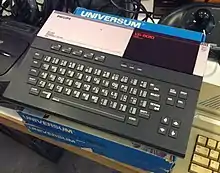.jpg.webp)
The Philips VG-8000, released in 1983, was the first Philips MSX computer, although it was not 100% compliant with the standard (as it lacked a Centronics printer port, expansion bus, or audio out, and had a custom video out).[1][2][3][4][5][6][7] It was released in Belgium, Finland, Germany, and Italy (as the Phonola VG-8000).[1][8]
The computer had a poor chiclet type keyboard, with two cartridge ports above it. The keyboard layout was qwerty or azerty, according to the market the computer was sold. It had five double function keys (F1 to F10) on top, and four arrow keys on the right. There were three color LEDs: Power (red), Caps (orange) and Code (green).[8]
There were three versions of this machine:[8]
- VG-8000/00, with qwerty keyboard and PAL composite video output;
- VG-8000/19, with azerty keyboard and RGB video output;
- VG-8000/20, with qwerty keyboard and PAL composite video output.
The machine was expensive and not successful.[1][2]

Philips VG 8010
The VG-8010, released in January 1984, was a more advanced model with 32KB of RAM, was popular in the Netherlands.[2][9][10][11][6] It had a retail price of 2290 Fr in France, in September 1985.[12] It was sold in Italy as the Phonola VG-8010.
There were two versions of this machine:[8]
- VG-8010/00, with qwerty keyboard and PAL composite video output;
- VG-8010/19, with azerty keyboard and RGB video output.
.jpg.webp)
Besides the mentioned Phonola branding, these machines were also sold under the Schneider and Radiola brands, as Schneider MC 810 and Radiola MK 180 (both with 48K RAM,with azerty keyboard and RGB video output).[8]
The VG-8000 and VG-8010 were built in France, at Le Mans by Radiotechnique.[12] They were replaced with the Philips VG-8020, a more advanced machine.[2][12]
Specifications
References
- 1 2 3 "Philips VG-8000". HomeComputerMuseum. Retrieved 2023-05-23.
- 1 2 3 4 "VG 8000 / 8010 Philips". www.old-computers.com. Retrieved 2023-05-22.
- ↑ "Philips VG 8000". www.silicium.org. Retrieved 2023-05-22.
- ↑ "Philips - VG 8000". www.system-cfg.com. Retrieved 2023-05-22.
- ↑ "Philips VG-8000". www.8bit-homecomputermuseum.at. Retrieved 2023-05-22.
- 1 2 3 4 5 Philips (1984). Philips VG8000/VG8010 Service Manual (GB).
- ↑ Valoroso, Amedeo (2023-01-13). "How to build an audio/video cable for MSX Philips VG 8000 VG 8010 VG 8020". Amedeo Valoroso. Retrieved 2023-05-23.
- 1 2 3 4 5 Amor, Jose Antonio Ortigueira (2020-05-17). "Retro Ordenadores Orty: Philips VG-8000 (versión VG 8000/00) (1984)". Retro Ordenadores Orty. Retrieved 2023-05-23.
- ↑ "Philips VG-8010". HomeComputerMuseum. Retrieved 2023-05-23.
- ↑ "Philips VG 8010". www.silicium.org. Retrieved 2023-05-22.
- ↑ "Philips - VG 8010". www.system-cfg.com. Retrieved 2023-05-22.
- 1 2 3 "Philips VG-8010". www.obsolete-tears.com. Retrieved 2023-05-23.